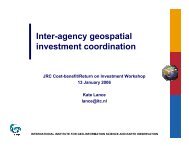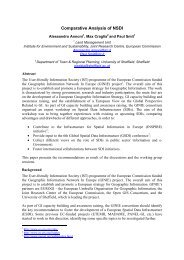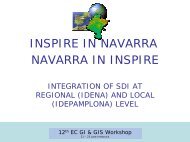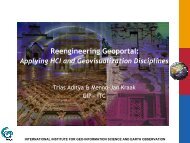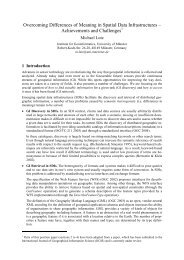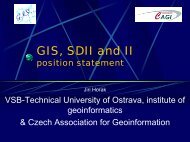session - EC GI & GIS Portal
session - EC GI & GIS Portal
session - EC GI & GIS Portal
You also want an ePaper? Increase the reach of your titles
YUMPU automatically turns print PDFs into web optimized ePapers that Google loves.
SESSION SDI<br />
makers, research institutes, governmental agencies, and clearinghouses organisations. In general, they focus on<br />
their own sector, and changes in institutional settings are extremely slow with an overall interest to protect<br />
their own interest. They do not differ in terms of purpose as any other horizontal data infrastructure,<br />
predominantly in terms of ICT functionalities and in the domain of policy making, governments tend to<br />
develop general spatial data infrastructure policies for facilitating the sharing of spatial data among different<br />
sectors.<br />
The successful grow of an infrastructure generates changes on their nature, scale, and purpose that in turn, will<br />
demand for adding new extensions to an existing infrastructure or for creating a complete new infrastructure.<br />
Most common is for adding new extensions to an existing infrastructure in the sense that their purpose remains<br />
the same, but the nature and scale are changed. Making or evolving to a new infrastructure means the creation<br />
of a new infrastructure or the change of purpose of an existing infrastructure. The latter usually occurs when<br />
changing from being a horizontal to a vertical infrastructure or vice-versa.<br />
Finally, the paper concludes that spatial data infrastructures are also unique in terms of its evolution process.<br />
This study envisages the evolution of current spatial data infrastructures into the realms of spatial information<br />
infrastructures, which implies the change from data horizontal infrastructures to information vertical<br />
infrastructures. Mainly because the observed trend is not to support generic products (e.g. new data types) for<br />
more users nor improve the quality of spatial data sets, but instead, the trend is focused on developing<br />
complementary geo-information services according to specific needs of a sector and its existing services.<br />
Although large investments have still to be made in the future, geo-information infrastructures having a<br />
vertical structure will provide greater efficiency, more effective analysis and modelling, and as a result, greater<br />
use. It is difficult to identify the driving force behind this particular development, but overall, it is a<br />
combination of the frustration of users and the innovations of technology However, more research is needed to<br />
discover the socio-economical process surrounding such an evolution of spatial data infrastructures.<br />
References<br />
Bernard, L., Craglia, M. Gould, M. and Kuhn, W. (2005). Towards an SDI research agenda. Proceedings of the<br />
11th <strong>EC</strong>_<strong>GI</strong>S Conference, Sardinia.<br />
Groot, R. (1997). Spatial data infrastructure (SDI) for sustainable land management. ITC Journal 3/4: 287-294.<br />
Groot, R. and McLaughlin, J. (2000). Geospatial Data Infrastructure: Concepts, Cases and Good Practice.<br />
Oxford: Oxford University Press.<br />
Star, S.L. and Ruhleder, K. (1996). Information Infrastructure Transition: Challenges with implementing<br />
standardised checklists. Proceedings of 22nd Information Systems Research Seminar in Scandinavia,<br />
T.K. Käkölä (ed.), Finland, pp. 95-110.<br />
Williamson, I., Rajabifard, A., and Feeney, M.E. (2003). Developing Spatial Data Infrastructures: From<br />
Concept to Reality. London: Taylor & Francis.<br />
Acknowledgements<br />
This research was supported by the Bsik Programme – Ruimte voor Geo-informatie (R<strong>GI</strong>) funding, under the<br />
project Development of framework to assess National Spatial Data Infrastructures, R<strong>GI</strong> 005.<br />
8





